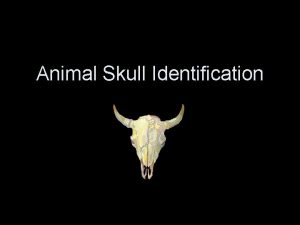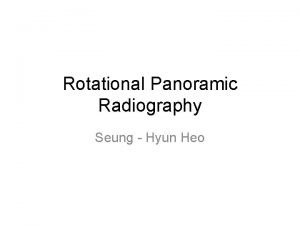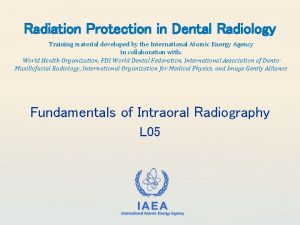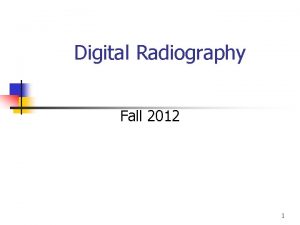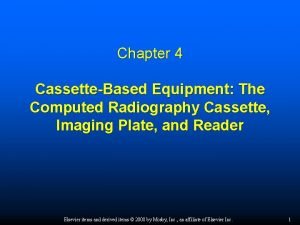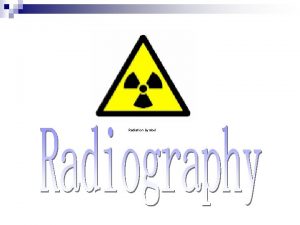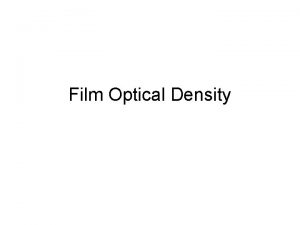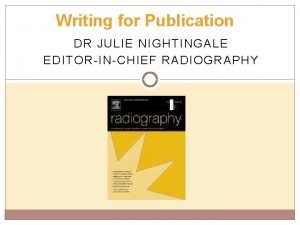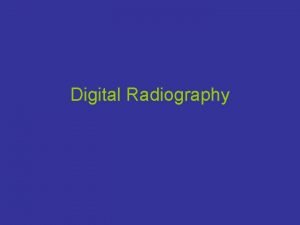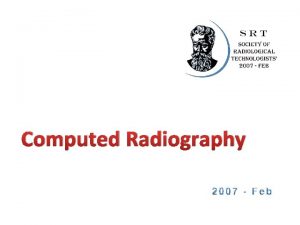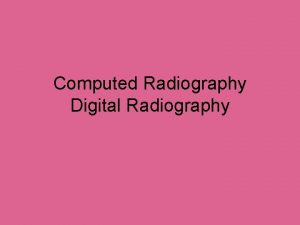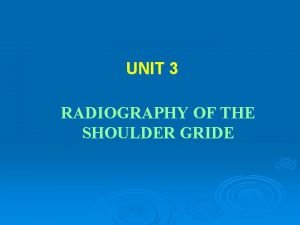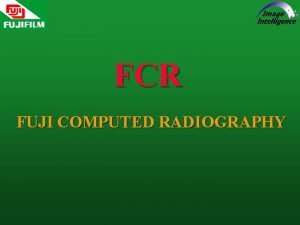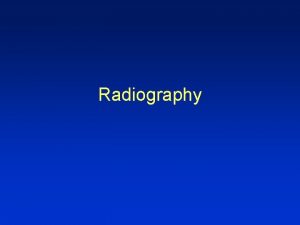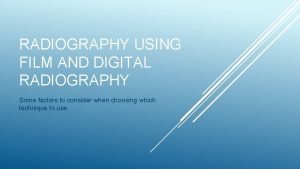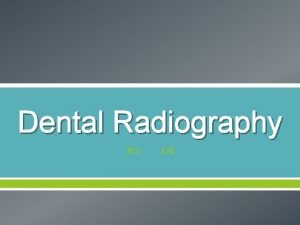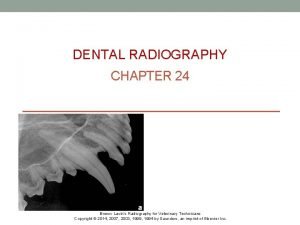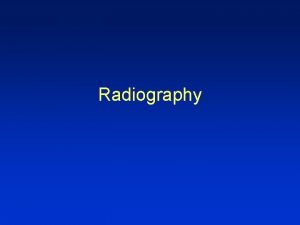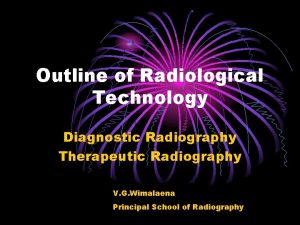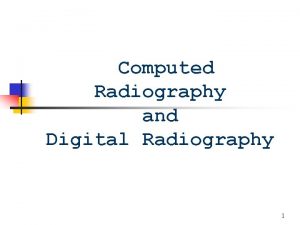Lecture 26 Skull Radiography Anatomy Review The skull



















- Slides: 19

Lecture (26)


Skull Radiography Anatomy Review • The skull encloses and protects the brain and its related structures. It is a solid bony box with a ‘back’ consisting of the occipital and parietal bones; a ‘top’ consisting of the frontal bone and two parietal bones Joined by the sagittal suture; right and left sides consisting of the parietal and Squamous temporal bones, a’ front’ consisting of the frontal bone and facial structures and a floor consisting of the occipital bone, petrous temporal and sphenoid bones. • The cranium is made up of 8 bones and the facial skeleton of 14 bones, with the exception of the mandible all are immovable and joined by sutures. The most complex part is the base which contains numerous foramina for the passage of arteries veins and cranial nerves.


Frontal Aspect of Skull Anatomy

1 -. Frontal Bone 2. Mandible 3. Maxilla 4. Zygoma 5. Greater wing of sphenoid 6. Parietal bone 7. Squamous temporal bone 8. Zygomatic arch 9. Mastoid process of temporal bone 10. Occipital.

Frontal Aspect of Skull Anatomy 1 -. Frontal bone 2. Mandible 5. Greater wing of sphenoid 7. Superior orbital fissure 3. Maxilla 4. Zygoma 6. Inferior orbital fissure 8. Nasal bone

Major Landmarks used for skull radiography: 1. Vertex 2. External Occipital Protuberance (E. O. P. ) 3. External Auditory Meatus 4. Outer Canthus Of Eye. 5. Infra-orbital point 6. Nasion 7. Glabella


Baselines, Body Planes and Major Landmarks • Accurate location of these lines, planes and points is essential to ensure accurate and reproducible positioning necessary for high quality imaging of • the skull and facial bones. Traditionally the planes and points have frequently used people’s names E. g. Reid’s Baseline but convention is now regarded as being as follows. Major body planes used in Skull radiography Median Sagittal Auricular Anthropological

• The Median Sagittal plane. • A vertical plane dividing the skull into 2 symmetrical right and left halves when viewed from the anterior aspect. • The Anthropological plane, • This plane splits the skull into upper and lower halves passing along the anthropological baselines. • The Auricular plane. • This plane divides the skull into anterior and posterior compartments along the Auricular lines.

Major Baselines used in Skull Radiography Anthropological Orbital Meatal Interpupillary

• The Anthropological line • The Isometric “Baseline” which runs from the inferior orbital margin to the upper border of the external auditory Meatus (EAM) • The Orbital- Meatal Line • The original “Baseline” which runs from the Nasion through the outer canthus of the eye to the centre of the external auditory meatus. • The Interpupillary line • The line connects the centres of the orbits and is at 90 degree to the median sagittal plane. • The Auricular Line (No Diagram) • This line passes at 90 degrees to the anthropological line through the centre of the external auditory meatus. • ( Note: there is a difference of 10 to 15 degrees between the Orbital-Meatal line and the anthropological line. )


• • • • Some Indications for Imaging Linear fractures Depressed fractures Basal skull fractures Gunshot wounds Neoplasm’s Metastases Osteolytic and osteoplastic lesions Multiple myloma Pituitary adenomas Paget’s disease Acoustic neuroma Sinusitis Para nasal sinuses polyps Otitis media Secondary osteomyelitis

• Patients Preparation: • Basic psychological preparation with reassurance and explanation of technique. • Before starting any examination, the identity of the patient must be checked by the radiographer; a patient may answer to a name not his/her own and this is particularly true for some disorientated patients attending for skull imaging. • All detachable foreign opacities such as jewellery chains, spectacles, hearing aids, earrings, wigs and false hairpieces and false eyes must be removed from the head and neck. It is not usually necessary to remove • false teeth. • It is important to remember the dignity of the patient, and essential to have clean hands and a clean table/buck top and clean immobilisation aids at all times.

• Radiation Protection: • Dose reduction. The most radiosensitive organs involved are the eyes and thyroid gland, the use of beam limiting cones and diaphragms is adequate in most cases, direct lead rubber gonad protection when the • Central ray is directed towards the gonads is probably not necessary but may be considered good practice. • The most effective method of dose reduction is careful technique to avoid the need for repeat radiographs. • Films Screen and Grids: • Stationary fine line grids with a ration of 10 or 12 to 1 or 8: 1 moving grid. • General purpose film screen combinations (Speed 400 to 800) are the best compromise of dose and image quality.

Common Positioning Errors Rotation and tilt are two of the most common positioning errors. A. Rotation occurs when the median Sagittal plane is not parallel to the film. • B. Tilt occurs when the interpupillary line is not at 90 ° to the film.

• Contra Indications: • There are few if any contra indications other than those alternative forms of imaging may be preferable or the fact that X-Ray imaging may be considered inappropriate in some cases where treatment will not be affected by the result of X-Ray examination. • A contra indication to the use of ionising radiation is the use of imaging in order to reduce the possibility of medico legal litigation and for psychological reassurance of the patient.
 Carnivore skull identification
Carnivore skull identification 01:640:244 lecture notes - lecture 15: plat, idah, farad
01:640:244 lecture notes - lecture 15: plat, idah, farad Focal trough in panoramic radiography
Focal trough in panoramic radiography What is grid frequency in radiography
What is grid frequency in radiography Bitewing periapical
Bitewing periapical Formation of latent image in radiography
Formation of latent image in radiography Dental radiographic interpretation ppt
Dental radiographic interpretation ppt Filmless radiography
Filmless radiography Oid and magnification
Oid and magnification X ray cassette construction
X ray cassette construction Additive and destructive pathology in radiography
Additive and destructive pathology in radiography Radiography safety precautions
Radiography safety precautions Single door system in darkroom
Single door system in darkroom Radiography cordon off distance formula
Radiography cordon off distance formula Optical density formula
Optical density formula Types of grid cut off
Types of grid cut off Gurney mott theory of latent image formation
Gurney mott theory of latent image formation Soot and whitewash radiography
Soot and whitewash radiography Industrial radiography accidents
Industrial radiography accidents Radiography
Radiography
